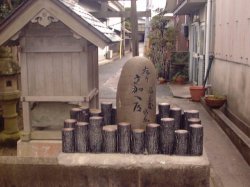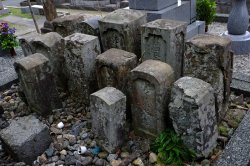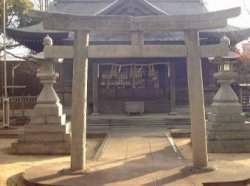境港市指定文化財の概要(3)
14)恵美須神社の道標石(Signpost stone of Ebisu Shrine)
■分類:民俗文化財(有形)
■指定年月日:平成14年7月1日
この道標石は、境港市内で確認された道標石としては唯一の存在である。
外江町は江戸時代に日本中の廻国行者たちが日本廻国したとき、石見八幡宮→出雲大社→伯耆大山へと廻国する一般的なルートの中にあった。
外江町に「左り、さかへ道」と案内した理由は、境→米子→大山寺へと廻国行者たちを道しるべする目的があったからであろう。人通りも増え、道に迷う人も多くあり、急遽、造立された道標の可能性が強い。
幕末におそらく海岸の交通路に、この石が立てられていたことであろう。
■公開状況:公開
■所在地:外江町
■アクセス方法:JR境港駅から約2.1km、徒歩27分
■指定年月日:平成14年7月1日
この道標石は、境港市内で確認された道標石としては唯一の存在である。
外江町は江戸時代に日本中の廻国行者たちが日本廻国したとき、石見八幡宮→出雲大社→伯耆大山へと廻国する一般的なルートの中にあった。
外江町に「左り、さかへ道」と案内した理由は、境→米子→大山寺へと廻国行者たちを道しるべする目的があったからであろう。人通りも増え、道に迷う人も多くあり、急遽、造立された道標の可能性が強い。
幕末におそらく海岸の交通路に、この石が立てられていたことであろう。
■公開状況:公開
■所在地:外江町
■アクセス方法:JR境港駅から約2.1km、徒歩27分
■ Classification: Folk Cultural Property (Tangible)
■ Designated Date: July 1, 2002
■ Designated Date: July 1, 2002
This signpost is the only signpost confirmed in Sakaiminato City.
Tonoe-cho was on the general route of Iwami Hachimangu → Izumo Taisha → Hakuya Daisen when the migrants from all over Japan traveled to Japan during the Edo period.
The reason why I guided Tonoe-cho to "Left, Sakahe-michi" is probably because it had the purpose of guiding the migrants from Sakai to Yonago to Daisenji. The number of people passing by has increased, and many people have lost their way, so there is a strong possibility that the signpost was built in a hurry.
At the end of the Tokugawa shogunate, this stone was probably erected on the coastal traffic route.
Tonoe-cho was on the general route of Iwami Hachimangu → Izumo Taisha → Hakuya Daisen when the migrants from all over Japan traveled to Japan during the Edo period.
The reason why I guided Tonoe-cho to "Left, Sakahe-michi" is probably because it had the purpose of guiding the migrants from Sakai to Yonago to Daisenji. The number of people passing by has increased, and many people have lost their way, so there is a strong possibility that the signpost was built in a hurry.
At the end of the Tokugawa shogunate, this stone was probably erected on the coastal traffic route.
■ Public status: Public
■ Location: Tonoecho
■ Access method: Approximately 2.1km from JR Sakaiminato Station, 27 minutes on foot
■ Location: Tonoecho
■ Access method: Approximately 2.1km from JR Sakaiminato Station, 27 minutes on foot
15)北前船船員墓碑群(Kitamaebune sailor tombstones)
■分類:民俗文化財(有形)
■指定年月日:平成14年7月1日
被葬者の出身地はおよそ北陸・山陰から紀伊・讃岐の名も見える。
江戸後期から明治前期にかけて、日本廻航路の主役となったのが北前船である。いわゆる西廻り回船(瀬戸内では北前船)の盛時と合致し、彼らがその乗船員であったことが推測される。
■公開状況:公開
■所在地:中野町 中央墓園内
■アクセス方法:JR馬場崎駅から約1km、徒歩13分
■指定年月日:平成14年7月1日
被葬者の出身地はおよそ北陸・山陰から紀伊・讃岐の名も見える。
江戸後期から明治前期にかけて、日本廻航路の主役となったのが北前船である。いわゆる西廻り回船(瀬戸内では北前船)の盛時と合致し、彼らがその乗船員であったことが推測される。
■公開状況:公開
■所在地:中野町 中央墓園内
■アクセス方法:JR馬場崎駅から約1km、徒歩13分
■ Classification: Tangible Cultural Property (Historic Site)
■ Designated Date: July 1, 2002
The birthplace of the burial person can be seen from Hokuriku / Sanin to Kii / Sanuki.
■ Designated Date: July 1, 2002
The birthplace of the burial person can be seen from Hokuriku / Sanin to Kii / Sanuki.
From the late Edo period to the early Meiji period, the Kitamaebune played a leading role in the Japanese route. It is presumed that they were the crew members of the so-called westbound kaisen (Kitamaebune in Setouchi).
■ Public status: Public
■ Location: Nakanocho Central Cemetery
■ Access method: Approximately 1km from JR Babasaki Station, 13 minutes on foot
■ Location: Nakanocho Central Cemetery
■ Access method: Approximately 1km from JR Babasaki Station, 13 minutes on foot
16)大港神社の手水鉢、石鳥居、長明燈一対(A pair of chozubachi, stone torii gate, and Chomei lantern at Ominato Shrine)
■分類:有形文化財(彫刻)
■指定年月日:平成14年7月1日
手水鉢は、御影石の明神型で文化3年(1806)に、丹後国由良庄(現在:京都府宮津市由良)の「舩持中」が奉納したもので、向かって右面に奉納年、左面に奉納者を刻んでいる。この手水鉢はおそらく北前船によって丹後国からはるばる運搬されてきたものと考えられる。
石鳥居は御影石製、明神型の一般的形式をもち、笠木、島木、貫、額束、柱(2本)を備えている。寛保3年(1743)5月に摂洲国脇浜浦(現在:兵庫県神戸市中央区脇浜町)の「廻舩中」が奉納したもので、右側の柱に現在は判読しにくいが、奉納者を縦に刻み、島木の下側部分に、奉納年月日を刻んでいる。
長明燈は、神社本殿の左右に設置された四角型の御影石製の灯籠で寛政7年(1795)8月に若狭国西津村(現在:福井県小浜市西津)の「古河嘉太夫教泰」が奉納したもの。竿の正面部分に「八幡宮」(社伝によると大港神社は、もとは「八幡宮」と称した)と大きな文字で記され、ほかの三面にそれぞれ「長明燈」、建立年月日、奉納者を刻んでいる。
■公開状況:公開
■所在地:栄町 大港神社内
■アクセス方法:JR境港駅から約800m、徒歩10分
■指定年月日:平成14年7月1日
手水鉢は、御影石の明神型で文化3年(1806)に、丹後国由良庄(現在:京都府宮津市由良)の「舩持中」が奉納したもので、向かって右面に奉納年、左面に奉納者を刻んでいる。この手水鉢はおそらく北前船によって丹後国からはるばる運搬されてきたものと考えられる。
石鳥居は御影石製、明神型の一般的形式をもち、笠木、島木、貫、額束、柱(2本)を備えている。寛保3年(1743)5月に摂洲国脇浜浦(現在:兵庫県神戸市中央区脇浜町)の「廻舩中」が奉納したもので、右側の柱に現在は判読しにくいが、奉納者を縦に刻み、島木の下側部分に、奉納年月日を刻んでいる。
長明燈は、神社本殿の左右に設置された四角型の御影石製の灯籠で寛政7年(1795)8月に若狭国西津村(現在:福井県小浜市西津)の「古河嘉太夫教泰」が奉納したもの。竿の正面部分に「八幡宮」(社伝によると大港神社は、もとは「八幡宮」と称した)と大きな文字で記され、ほかの三面にそれぞれ「長明燈」、建立年月日、奉納者を刻んでいる。
■公開状況:公開
■所在地:栄町 大港神社内
■アクセス方法:JR境港駅から約800m、徒歩10分
■ Classification: Tangible cultural property (sculpture)
■ Designated date: July 1, 2002
The hand water bowl is a Myojin type of Mikage stone, and in 1806, Yurasho, Tango Province (currently Miyazu City, Kyoto Prefecture) It was dedicated by Yura)'s "Cultural Property", with the year of dedication on the right side and the dedicator on the left side. It is probable that this chozubachi was transported all the way from Tango Province by the Kitamaebune.
■ Designated date: July 1, 2002
The hand water bowl is a Myojin type of Mikage stone, and in 1806, Yurasho, Tango Province (currently Miyazu City, Kyoto Prefecture) It was dedicated by Yura)'s "Cultural Property", with the year of dedication on the right side and the dedicator on the left side. It is probable that this chozubachi was transported all the way from Tango Province by the Kitamaebune.
The stone torii is made of granite and has a general form of Myojin type, and is equipped with Kasagi, Shimaki, Kan, forehead bundle, and pillars (2). It was dedicated by "Wakinohama-cho" in Wakinohama-cho, Kobe City, Hyogo Prefecture in May 1743, and is currently difficult to read on the right pillar. The dedicator is carved vertically, and the date of dedication is engraved on the lower part of the island tree.
The Chomei lantern is a square-shaped lantern made of Mikage stone installed on the left and right of the main shrine, and in August 1795, "Katao Furukawa" from Nishizu Village, Wakasa Province (currently Nishizu, Obama City, Fukui Prefecture) Dedicated. "Hachimangusha" (Ominato Shrine was originally called "Hachimangusha" according to the company's biography) is written in large letters on the front part of the rod, and "Chomei-to", the date of construction, and the dedicator on the other three sides, respectively. Is carved.
The Chomei lantern is a square-shaped lantern made of Mikage stone installed on the left and right of the main shrine, and in August 1795, "Katao Furukawa" from Nishizu Village, Wakasa Province (currently Nishizu, Obama City, Fukui Prefecture) Dedicated. "Hachimangusha" (Ominato Shrine was originally called "Hachimangusha" according to the company's biography) is written in large letters on the front part of the rod, and "Chomei-to", the date of construction, and the dedicator on the other three sides, respectively. Is carved.
■ Public status: Public
■ Location: Sakaechou Ominato Shrine
■ Access method: Approximately 800m from JR Sakaiminato Station, 10 minutes on foot
■ Location: Sakaechou Ominato Shrine
■ Access method: Approximately 800m from JR Sakaiminato Station, 10 minutes on foot
17)記念碑(山陰鐵道発祥之地)( Monument (Birthplace of Sanin Railway))
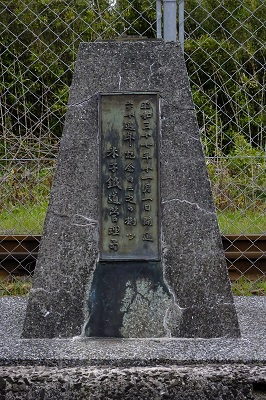
■分類:記念物(史跡)
■指定年月日:平成14年7月1日
明治35年11月1日、山陰地方最初の鉄道開通を記念した碑。
山陰地方の鉄道建設は明治33年5月に着手され、境港湾を利用して資材海上輸送によって同年10月、大正町岸壁から鉄路敷設工事が開始された。
昭和37年11月1日、山陰鉄道開通60周年を記念して境港市から国鉄米子管理局へ寄贈され、境~御来屋間営業運転開始時の境停車場があった馬場崎町の現在地に造立された。
■公開状況:公開
■所在地:馬場崎町
■アクセス方法:JR馬場崎駅から約200m、徒歩3分
■指定年月日:平成14年7月1日
明治35年11月1日、山陰地方最初の鉄道開通を記念した碑。
山陰地方の鉄道建設は明治33年5月に着手され、境港湾を利用して資材海上輸送によって同年10月、大正町岸壁から鉄路敷設工事が開始された。
昭和37年11月1日、山陰鉄道開通60周年を記念して境港市から国鉄米子管理局へ寄贈され、境~御来屋間営業運転開始時の境停車場があった馬場崎町の現在地に造立された。
■公開状況:公開
■所在地:馬場崎町
■ Classification: Tangible cultural property (sculpture)
■ Designated date: July 1, 2002
The hand water bowl is a Myojin type of Mikage stone, and in 1806, Yurasho, Tango Province (currently Miyazu City, Kyoto Prefecture) It was dedicated by Yura)'s "Cultural Property", with the year of dedication on the right side and the dedicator on the left side. It is probable that this chozubachi was transported all the way from Tango Province by the Kitamaebune.
■ Designated date: July 1, 2002
The hand water bowl is a Myojin type of Mikage stone, and in 1806, Yurasho, Tango Province (currently Miyazu City, Kyoto Prefecture) It was dedicated by Yura)'s "Cultural Property", with the year of dedication on the right side and the dedicator on the left side. It is probable that this chozubachi was transported all the way from Tango Province by the Kitamaebune.
The stone torii is made of granite and has a general form of Myojin type, and is equipped with Kasagi, Shimaki, Kan, forehead bundle, and pillars (2). It was dedicated by "Wakinohama-cho" in Wakinohama-cho, Kobe City, Hyogo Prefecture in May 1743, and is currently difficult to read on the right pillar. The dedicator is carved vertically, and the date of dedication is engraved on the lower part of the island tree.
The Chomei lantern is a square-shaped lantern made of Mikage stone installed on the left and right of the main shrine, and in August 1795, "Katao Furukawa" from Nishizu Village, Wakasa Province (currently Nishizu, Obama City, Fukui Prefecture) Dedicated. "Hachimangusha" (Ominato Shrine was originally called "Hachimangusha" according to the company's biography) is written in large letters on the front part of the rod, and "Chomei-to", the date of construction, and the dedicator on the other three sides, respectively. Is carved.
The Chomei lantern is a square-shaped lantern made of Mikage stone installed on the left and right of the main shrine, and in August 1795, "Katao Furukawa" from Nishizu Village, Wakasa Province (currently Nishizu, Obama City, Fukui Prefecture) Dedicated. "Hachimangusha" (Ominato Shrine was originally called "Hachimangusha" according to the company's biography) is written in large letters on the front part of the rod, and "Chomei-to", the date of construction, and the dedicator on the other three sides, respectively. Is carved.
■ Public status: Public
■ Location: Sakaechou Ominato Shrine
■ Access method: Approximately 800m from JR Sakaiminato Station, 10 minutes on foot
■ Location: Sakaechou Ominato Shrine
■ Access method: Approximately 800m from JR Sakaiminato Station, 10 minutes on foot
■アクセス方法:JR馬場崎駅から約200m、徒歩3分
18)板碑群(Itabi group)
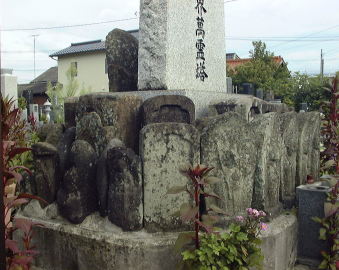
■分類:民俗文化財(有形)
■指定年月日:平成14年7月1日
板碑は江戸時代以前の供養塔である。
山陰地方によく見られる板碑は、自然石の頭部を三角形に、その下に座像の如来像を浮彫りにしたものが多い。このような板碑は、京都地方を中心として、若狭の美方五湖周辺に多い。そして、中世戦国時代のころ、海運によって山陰地方の港へと運ばれて来たと推定されている。
境港には、かつて「千坊」と呼ばれた共同墓地があり、そこに7体の板碑が安置されていたが、今は散逸している。その中の5体が馬場崎町墓地に移されて現存している。
■公開状況:公開
■所在地:馬場崎町 馬場崎墓地内
■アクセス方法:JR馬場崎駅から約200m、徒歩3分
■指定年月日:平成14年7月1日
板碑は江戸時代以前の供養塔である。
山陰地方によく見られる板碑は、自然石の頭部を三角形に、その下に座像の如来像を浮彫りにしたものが多い。このような板碑は、京都地方を中心として、若狭の美方五湖周辺に多い。そして、中世戦国時代のころ、海運によって山陰地方の港へと運ばれて来たと推定されている。
境港には、かつて「千坊」と呼ばれた共同墓地があり、そこに7体の板碑が安置されていたが、今は散逸している。その中の5体が馬場崎町墓地に移されて現存している。
■公開状況:公開
■所在地:馬場崎町 馬場崎墓地内
■アクセス方法:JR馬場崎駅から約200m、徒歩3分
■ Classification: Tangible Cultural Property (Historic Site)
■ Designated Date: July 1, 2002
The Itabi is a memorial tower before the Edo period.
■ Designated Date: July 1, 2002
The Itabi is a memorial tower before the Edo period.
Many of the itabi monuments that are often seen in the San'in region have the head of a natural stone in a triangular shape, and the sitting statue of Nyorai is embossed underneath. There are many such itabi around Mikatagoko in Wakasa, mainly in the Kyoto region. It is estimated that it was transported to a port in the San'in region by shipping during the Warring States period in the Middle Ages.
At Sakaiminato, there used to be a communal graveyard called "Senbo," where seven itabi monuments were enshrined, but they are now scattered. Five of them have been moved to the Babasakicho Cemetery and are still in existence.
At Sakaiminato, there used to be a communal graveyard called "Senbo," where seven itabi monuments were enshrined, but they are now scattered. Five of them have been moved to the Babasakicho Cemetery and are still in existence.
■ Public status: Public
■ Location: Babasaki-cho Babasaki Cemetery
■ Access method: Approximately 200m from JR Babasaki Station, 3 minutes on foot
■ Location: Babasaki-cho Babasaki Cemetery
■ Access method: Approximately 200m from JR Babasaki Station, 3 minutes on foot
19)外江村 下札(Tonoemura Sagefuda)
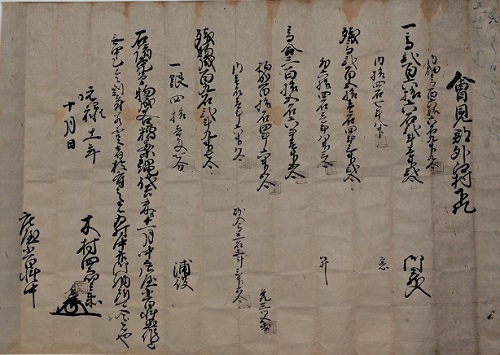
■分類:有形文化財(古文書)
■指定年月日:平成14年7月1日
江戸時代には、納税は米で納めた。鳥取藩から各村々へ、一村あてに一年分の納める米高を指示した「年貢割り当て状」が「下札」である。
外江村の下札は、寛永13年(1636)から嘉元年(1848)までの77点が大切に残されている。
■公開状況:非公開
■所在地:上道町 市史編さん室内
■アクセス方法:JR馬場崎駅から約700m、徒歩9分
■指定年月日:平成14年7月1日
江戸時代には、納税は米で納めた。鳥取藩から各村々へ、一村あてに一年分の納める米高を指示した「年貢割り当て状」が「下札」である。
外江村の下札は、寛永13年(1636)から嘉元年(1848)までの77点が大切に残されている。
■公開状況:非公開
■所在地:上道町 市史編さん室内
■アクセス方法:JR馬場崎駅から約700m、徒歩9分
■ Classification: Folk cultural property (tangible)
■ Designated date: July 1, 2002
In the Edo period, tax was paid in rice. The "annual tribute allocation letter" that instructed each village from the Tottori domain to pay the amount of rice for one year to one village is the "lower bill".
77 points from Kanei 13 (1636) to Kagen (1848) are carefully preserved in the lower tag of Sotoe Village.
■ Designated date: July 1, 2002
In the Edo period, tax was paid in rice. The "annual tribute allocation letter" that instructed each village from the Tottori domain to pay the amount of rice for one year to one village is the "lower bill".
77 points from Kanei 13 (1636) to Kagen (1848) are carefully preserved in the lower tag of Sotoe Village.
■ Public status: Private
■ Location: Agarimichicho City History Edition
■ Access method: Approximately 700m from JR Babasaki Station, 9 minutes on foo
■ Location: Agarimichicho City History Edition
■ Access method: Approximately 700m from JR Babasaki Station, 9 minutes on foo
20)松尾芭蕉の句碑(Matsuo Basho's monument)
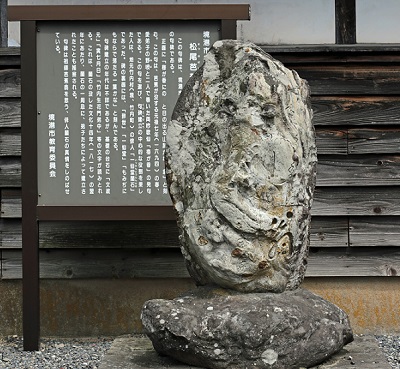
■分類:有形文化財(彫刻)
■指定年月日:平成14年7月1日
市内に残されている唯一基の松尾芭蕉の句碑である。
正面に「梅が香にのっと日の出る山路かな」「翁」と刻む。この句は、芭蕉が没する元禄7年(1694)の春、愛弟子の野坡と二人で巻いた両吟歌仙「梅が香」の発句である。
句碑建立の中心的な役割を果した人は、地元竹内村(現、竹内町)の俳人「一仙堂蘭石」であった。碑の裏面には、「辞世」「一仙堂」「もみぢにもならで落たる一葉かな」と刻んである。
■公開状況:公開
■所在地:中野町 正福寺内
■アクセス方法:JR上道駅から約550m、徒歩7分
■指定年月日:平成14年7月1日
市内に残されている唯一基の松尾芭蕉の句碑である。
正面に「梅が香にのっと日の出る山路かな」「翁」と刻む。この句は、芭蕉が没する元禄7年(1694)の春、愛弟子の野坡と二人で巻いた両吟歌仙「梅が香」の発句である。
句碑建立の中心的な役割を果した人は、地元竹内村(現、竹内町)の俳人「一仙堂蘭石」であった。碑の裏面には、「辞世」「一仙堂」「もみぢにもならで落たる一葉かな」と刻んである。
■公開状況:公開
■所在地:中野町 正福寺内
■アクセス方法:JR上道駅から約550m、徒歩7分
■ Classification: Tangible Cultural Property (Historic Site)
■ Designated Date: July 1, 2002
This is the only monument of Basho Matsuo left in the city.
Engrave "Is it a mountain road where plums rise with incense" and "Okina" on the front. This phrase is a phrase of "Ume ga Kaori", which was wrapped with his beloved disciple Nobo in the spring of Genroku 7 (1694), when Basho died.
The person who played a central role in the construction of the monument was the poet "Isendo Ranshi" from the local Takenouchi village (currently Takenouchi-cho). The back of the monument is engraved with the words "Death poem," "Ichisendo," and "Is it a leaf that falls uniquely to Momiji?"
■ Designated Date: July 1, 2002
This is the only monument of Basho Matsuo left in the city.
Engrave "Is it a mountain road where plums rise with incense" and "Okina" on the front. This phrase is a phrase of "Ume ga Kaori", which was wrapped with his beloved disciple Nobo in the spring of Genroku 7 (1694), when Basho died.
The person who played a central role in the construction of the monument was the poet "Isendo Ranshi" from the local Takenouchi village (currently Takenouchi-cho). The back of the monument is engraved with the words "Death poem," "Ichisendo," and "Is it a leaf that falls uniquely to Momiji?"
■ Public status: Public
■ Location: Nakanocho Shofukuji
■ Access method: Approximately 550m from JR Agarimichi Station, 7 minutes on foot
■ Location: Nakanocho Shofukuji
■ Access method: Approximately 550m from JR Agarimichi Station, 7 minutes on foot
問い合わせ先(Contact)
教育委員会事務局 生涯学習課 文化体育係
電話 :0859-47-1092
FAX:0859-47-1100
Lifelong Learning Division Cultural and Physical Education Section (0859-47-1092)

